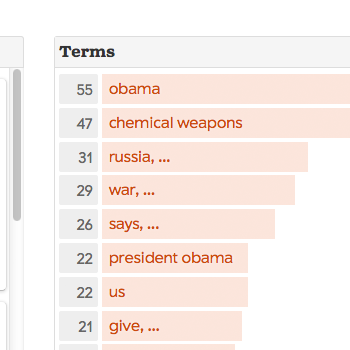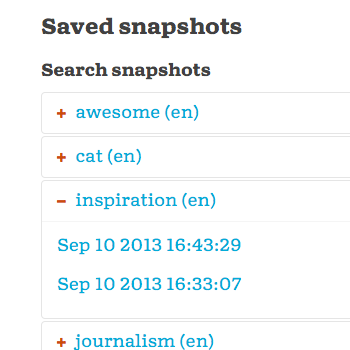About
TwXplorer helps you understand what people are talking about on Twitter. Simply search for a word or phrase and twXplorer automatically shows you the most commonly used words and hashtags and the mostly frequently shared links. Explore the results by filtering terms from your original query.
Want to understand a specific Twitter community? TwXplorer gives you all the tools above to explore Twitter lists you have created or are subscribed to.
Designed as a tool for researchers and journalists, you can save your results as a "snapshot" for later review.
How it works
Sign In
You have to sign in before you can use twXplorer. You do this using OAuth, which is an authentication protocol that allows users to approve applications to act on their behalf without sharing their password. We only request read access (as opposed to read/write access). The application can only read data and has no ability to update any user's information.
The Twitter API is rate-limited, only allowing clients to make a limited number of calls per hour. Unauthenticated calls are measured against the public facing IP address of the server or device making the request. Authenticated calls are measured against the access token used in the request. Requiring the user to sign-in means each user will have a unique access token. Therefore, the rate limits are applied per user (as opposed to all twXplorer users).
Requiring sign in also allows us to save private, per-user data (e.g. saved results), and to let you to use the Twitter lists feature of twXplorer.
Search queries
 Enter a query in the search box, pick a language, and hit the search button. To provide a relatively swift response, and comply with Twitter's API limits, twXplorer finds the 500 most recent tweets that include your search terms. We analyze them and display the results. We do not display duplicate "new style" retweets, though the terms in retweets are counted in the bar graph that twXplorer displays. If twXplorer reports finding 400 tweets, it means it found 400 unique tweets–which you can scroll through–and 100 “new style” retweets.
Enter a query in the search box, pick a language, and hit the search button. To provide a relatively swift response, and comply with Twitter's API limits, twXplorer finds the 500 most recent tweets that include your search terms. We analyze them and display the results. We do not display duplicate "new style" retweets, though the terms in retweets are counted in the bar graph that twXplorer displays. If twXplorer reports finding 400 tweets, it means it found 400 unique tweets–which you can scroll through–and 100 “new style” retweets.
The language selection will restrict the search to tweets in a given language. Twitter offers "best-effort" language detection, which is very good but not perfect.
Search results
 For any search terms you enter into twXplorer, you get four different ways to see your search results:
For any search terms you enter into twXplorer, you get four different ways to see your search results:
- Up to 500 recent tweets containing the terms you entered.
- In tweets that include your search terms, a bar graph showing the most popular other words that appear.
- The most popular hashtags included in tweets containing your search terms
- The most popular links in tweets containing your search terms.
TwXplorer excludes common words like “the”. Then it looks not only for single words, but also user mentions (such as @KnightLab) and hashtag text (#chicago counts as “chicago”). It also looks for “bigrams” (two-word phrases) that show up more than once. If a bigram is common (say, “white house”), twXplorer doesn't count them again as separate terms. TwXplorer groups terms together when they have a common stem (“look,” “looks” and “looking” are counted as the same term).
You can click on any item in a histogram, and it will appear above the histograms as a filter item. The list of tweets and histograms always reflects the current filter state. The filters are connected through an "and" Boolean search. For example, if you have filtered separately by "chicago" and "bulls", the displayed results will reflect only those tweets that contain both "chicago" and "bulls".
You can remove the filter by clicking on the "x" next to it at the top of the page.
The Twitter Search API is not an exhaustive source of Tweets. Not all Tweets are indexed or made available.
Lists
This search provides information about tweets on Twitter lists you have created or subscribed to (maximum of 100). Select a list, pick a language, and hit the search button. We contact Twitter and request the 500 most recent tweets authored by members of the selected list. Then we analyze them and display the results.
For lists, the language you specify doesn't change what tweets Twitter returns to us. However, the language you specify gives twXplorer a clue about which common words to ignore when producing the term histogram.
Snapshots
 You can save a set of results by clicking on "Save Snapshot." You can view everything you've saved by clicking on "saved snapshots."
You can save a set of results by clicking on "Save Snapshot." You can view everything you've saved by clicking on "saved snapshots."
The snapshots are displayed by the date/time when you saved them and grouped by query or list (depending on how you obtained the results). Click on any snapshot to review it. You can explore a saved snapshot in the same way you explore live search results; you can drill down by clicking on any term.
A snapshot can be deleted by checking the box next to it and clicking the "Delete selected snapshots" button.